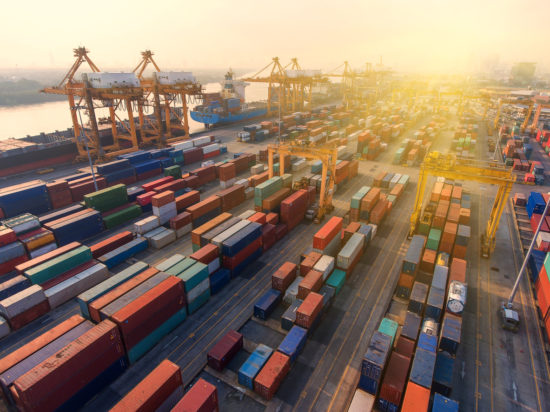Tariffs, Free Trade, and Politics
On March 8, President Trump followed through with plans to impose new tariffs on imported steel and aluminum. In the Q&A that follows, Stanford Law Professor Alan Sykes discusses the new executive order.
Can you explain the highlights of this executive order, which are being described as “sweeping and stiff” tariffs on imported steel and aluminum, and why they were passed via executive action?
Two Presidential Proclamations have imposed additional tariffs of 25% ad valorem on most items deemed to be “steel and articles thereof” and 10% ad valorem on most items deemed to be “aluminum and articles thereof,” except for steel and aluminum imports from Canada and Mexico. The ostensible rationale for the tariffs is a threat to national security from imports of these articles. The authority for higher tariffs is found in Section 232 of the Trade Expansion Act of 1962, which permits tariff increases for national security purposes after an investigation by the Commerce Department. The Presidential Proclamations also provide a mechanism for particular steel and aluminum products to be excluded from higher tariffs if they are not produced in sufficient quantities in the United States to meet U.S. needs, or (rather ironically) if the application of higher tariffs would impair national security. They also invite nations other than Canada and Mexico whose exports to the United States threaten national security to discuss “alternative ways to address the threatened impairment of the national security caused by imports from that country,” and thereby potentially also to gain an exemption from the tariffs.
The initial country exemptions, and the possibility of others following discussions, raise a question of whether the new tariffs are seriously aimed at protecting the steel and aluminum industries, or are instead aimed at stimulating negotiations and wringing new concessions from affected countries.
Canada and Mexico are exempt from this tariff. Why?

The President deems them to represent a “special case” based on “our shared commitment to supporting each other in addressing national security concerns, our shared commitment to addressing global excess capacity for producing [steel and aluminum], the physical proximity of our respective industrial bases, [and the] robust economic integration between our countries.” On this basis, the Proclamations declare that the best way to address the threat to national security from Canadian and Mexican imports is through ongoing negotiations, presumably in conjunction with current NAFTA talks.
Is the national security rationale for the higher tariffs sound?
The argument that imports threaten national security is dubious. To take the case of steel, the United States currently produces about 70% of the steel that it consumes. According to the Commerce Department Report pursuant to Section 232, the Department of Defense currently consumes steel equal to about 3% of annual U.S. production. The sixteen so-called “critical industries” identified by the Commerce Department in its report (ranging from transportation to chemicals to energy to agriculture) currently consume steel equal to about 50% of U.S. annual production. U.S. capacity utilization in the steel industry is around 70%, and so U.S. production could in principle increase by over 40% if needed for some sort of national emergency. In addition, the bulk of our steel imports come from reliable allies – Canada is the number one supplier, followed by EU countries in the aggregate, then Brazil, South Korea and Mexico. Japan, Taiwan and India are also in the top ten. Russia is sixth, and China tenth.
The situation with aluminum is only somewhat different. Imports supply over half of U.S. consumption, but U.S. production still far exceeds current consumption of aluminum for defense purposes. And once again the largest source of imports is Canada, which supplies nearly half of U.S. aluminum imports.
It is true that domestic steel and aluminum producers (particularly primary aluminum producers, as opposed to secondary or recycled aluminum producers) exhibit a gradual downtrend in production and employment in recent years. But it is by no means clear that they have reached the point, or are likely to reach the point in the future, where their overall capacity plus the available imports from reliable foreign sources of supply would fall short of national needs in the face of any plausible national emergency.
That said, within the broad categories of products covered by the new tariffs, certain specific products are not manufactured in substantial quantity or at all in the United States, and some of them have important national defense uses. To the extent that this situation raises bona fide security concerns, however, across the board tariffs on all steel and aluminum products are a questionable policy response. A more logical approach might be to purchase such products at low world prices today and stockpile them for future needs in time of emergency.
Will the new tariffs reverse the gradual decline in U.S. steel and aluminum industries and bring back lost jobs?
The answer is – only to a limited extent, at best. Tariffs may stimulate some additional output from U.S. firms in the short term. Economic studies suggest that the bulk of the jobs lost in U.S. manufacturing industries, however, are due to technical change (automation) rather than trade, and so tariffs to some extent will simply cause automated processes to work harder. Moreover, the exemptions for Canada and Mexico will divert import demand to these sources of supply, and we may see in substantial measure a rearrangement of global patterns of steel and aluminum trade more than a large reduction in overall U.S. imports. Finally, the likely duration of the new tariffs is entirely unclear, and it seems improbable that investors will pour new capital into domestic production on the basis of tariff protection that may be gone before new capacity can be constructed.
A further issue concerns the downstream effects of the tariffs. A similar case arose in the 1980s when the U.S. copper industry sought tariffs under the “safeguard” provisions of U.S. law (which served as the basis for the recent tariffs on solar cells and washing machines). The International Trade Commission recommended high tariffs on refined copper imports, but President Reagan declined to impose them. An important consideration in that decision was evidence that downstream job loss – particularly in wire mills and brass mills that depend on copper as an input – would exceed any job gains in copper mining and refining. The same issue arises here. Will increased prices for steel and aluminum result in more imports of downstream products that compete with U.S. firms, and cost substantial numbers of jobs in domestic steel and aluminum consuming industries?

Finally, it is worth noting that the new tariffs may beget prompt retaliation (the EU has threatened it already). And so one must be concerned about job loss in our exporting industries in response to the new tariffs.
Are the new tariffs permissible under existing international trade agreements?
The legality of the new tariffs under WTO rules is uncertain, and pertinent legal precedent is scant. If the tariffs last long enough, however, we may see a ruling on the issue.
The tariffs plainly violate basic tariff commitments made by the United States under GATT Article II. With regard to the WTO, however, GATT Article XXI contains an exception to WTO obligations that allows a WTO member nation to take measures “it considers necessary” to protect “essential security interests” relating to traffic in goods and materials “carried on directly or indirectly for the purpose of supplying a military establishment” or taken in time of “emergency in international relations.” The phrase “it considers necessary” makes Article XXI a provision that is “self-judging” and renders its invocation unreviewable at least to a degree. But the question that has never been answered is whether the existence of an “emergency” might be reviewable by a dispute panel, or whether a panel might have the authority to review whether the measures at issue are truly for the purpose of “supplying a military establishment.” In addition, the Vienna Convention on the Law of Treaties, routinely applied in WTO adjudication, requires treaty signatories to perform in “good faith,” which offers another possible avenue of review if adjudicators suspect that the national security justification is largely pretense.
If a case is brought and ultimately adjudicated, it could go either way. A victory for the complaining nation(s) would no doubt provoke serious backlash against the WTO in the United States, while a victory for the United States would suggest that any nation can invoke dubious “security” claims to evade its WTO commitments any time it wants. Neither outcome would be healthy for the WTO or for the trading system. WTO officials thus hope that no formal complaint will be brought, or else that the controversy will be settled before any adjudication can conclude.
The U.S. has generally advocated for more liberal trade since the mid-1930s. Does this announcement, and the tariffs announced earlier this year on solar cells and washing machines, represent an abandonment of free trade advocacy?
Actually, the United States has waxed and waned on the virtues of liberal trade. But an unusual feature of the current turn toward protectionism is the fact that the economy is performing very well overall, and one cannot link protectionist sentiment to the business cycle. Instead, certain industries, particularly traditional manufacturing industries, are struggling in spite of favorable economic conditions elsewhere, particularly as measured by long-term trends in their employment levels. Liberal trade is a piece of the problem, but technological change is the greater part of it as noted earlier. Regardless of the cause, politicians in both parties are advocating protectionist policies to compete for votes in the areas most affected by these difficulties, which include some important swing states. Time will tell whether this decoupling of protectionist sentiment from the business cycle will persist and lead to a lasting protectionist drift in domestic politics.
Alan O. Sykes is Professor of Law and director of the Masters Program in International Economic Law, Business and Policy at Stanford Law School. He is also a senior fellow at the Stanford Institute for Economic Policy Research (SIEPR).
